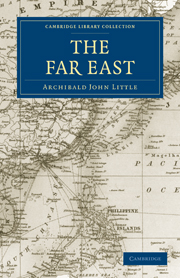Book contents
- Frontmatter
- PREFACE
- EDITORIAL NOTE
- Contents
- LIST OF MAPS AND ILLUSTRATIONS
- CHAPTER I DEFINITION
- CHAPTER II THE CENTRAL KINGDOM: CHINA
- CHAPTER III THE NORTHERN BASIN. THE YELLOW RIVER
- CHAPTER IV THE MIDDLE BASIN: PART I. THE YANGTSE RIVER
- CHAPTER V THE MIDDLE BASIN: PART II. THE PROVINCE OF SZECHUAN
- CHAPTER VI THE MIDDLE BASIN: PART III. THE CHENGTU PLATEAU
- CHAPTER VII THE MIDDLE BASIN: PART IV. THE LOWER YANGTSE PROVINCES
- CHAPTER VIII THE INTERMEDIATE PROVINCES
- CHAPTER IX THE SOUTHERN BASIN. YUNNAN TO CANTON
- CHAPTER X THE DEPENDENCIES: PART I. MANCHURIA
- CHAPTER XI THE DEPENDENCIES: PART II. MONGOLIA
- CHAPTER XII THE DEPENDENCIES: PART III. TURKESTAN
- CHAPTER XIII THE DEPENDENCIES: PART IV. TIBET
- CHAPTER XIV WHILOM DEPENDENCIES: PART I. INDO-CHINA
- CHAPTER XV WHILOM DEPENDENCIES: PART II. COREA
- CHAPTER XVI THE BUFFER KINGDOM: SIAM
- CHAPTER XVII THE ISLAND EMPIRE: JAPAN
- INDEX
- Plate section
CHAPTER VI - THE MIDDLE BASIN: PART III. THE CHENGTU PLATEAU
Published online by Cambridge University Press: 05 October 2010
- Frontmatter
- PREFACE
- EDITORIAL NOTE
- Contents
- LIST OF MAPS AND ILLUSTRATIONS
- CHAPTER I DEFINITION
- CHAPTER II THE CENTRAL KINGDOM: CHINA
- CHAPTER III THE NORTHERN BASIN. THE YELLOW RIVER
- CHAPTER IV THE MIDDLE BASIN: PART I. THE YANGTSE RIVER
- CHAPTER V THE MIDDLE BASIN: PART II. THE PROVINCE OF SZECHUAN
- CHAPTER VI THE MIDDLE BASIN: PART III. THE CHENGTU PLATEAU
- CHAPTER VII THE MIDDLE BASIN: PART IV. THE LOWER YANGTSE PROVINCES
- CHAPTER VIII THE INTERMEDIATE PROVINCES
- CHAPTER IX THE SOUTHERN BASIN. YUNNAN TO CANTON
- CHAPTER X THE DEPENDENCIES: PART I. MANCHURIA
- CHAPTER XI THE DEPENDENCIES: PART II. MONGOLIA
- CHAPTER XII THE DEPENDENCIES: PART III. TURKESTAN
- CHAPTER XIII THE DEPENDENCIES: PART IV. TIBET
- CHAPTER XIV WHILOM DEPENDENCIES: PART I. INDO-CHINA
- CHAPTER XV WHILOM DEPENDENCIES: PART II. COREA
- CHAPTER XVI THE BUFFER KINGDOM: SIAM
- CHAPTER XVII THE ISLAND EMPIRE: JAPAN
- INDEX
- Plate section
Summary
This unique area of level land in the wide, otherwise purely mountainous, region of Szechuan cannot be passed over in a general description of the province, but demands a short essay to itself, so important is its relation to the rest of the province and so peculiar are its characteristics in China, and, we may confidently add, in the world at large. There are other lake basins now dry and converted into fertile agricultural land, but we know of no other similarly isolated basin, unless it be that of the Great Salt Lake in North America, that depends for its perennial fertility upon a so complicated and original system of artificial irrigation as that which we see to-day exhibited in the Chengtu plain. This plain is, roughly speaking, a parallelogram measuring some seventy miles south-west and north-east by about forty miles north-west to south-east, thus possessing an area of about 2,800 square miles—just that of County Cork in Ireland, and little more than half the area of the one county of York in England, but probably the most highly productive and thickly populated piece of land of its size on the surface of the globe: the population of the county of London may possibly be still closer packed, but there is no comparison in the relative productiveness of the soil, due, in the case of Chengtu plain, to its artificial enrichment by the return to the soil of all the refuse matter emanating from a dense population, coupled with a system of irrigation the most elaborate conceivable.
- Type
- Chapter
- Information
- The Far East , pp. 78 - 90Publisher: Cambridge University PressPrint publication year: 2010First published in: 1905



